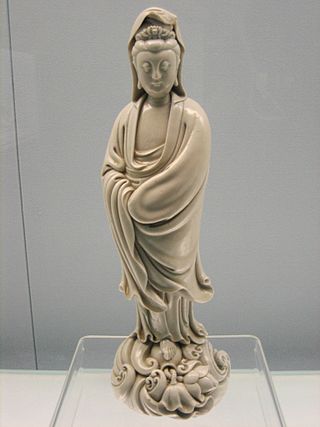
A figurine or statuette is a small, three-dimensional sculpture that represents a human, deity or animal, or, in practice, a pair or small group of them. Figurines have been made in many media, with clay, metal, wood, glass, and today plastic or resin the most significant. Ceramic figurines not made of porcelain are called terracottas in historical contexts.
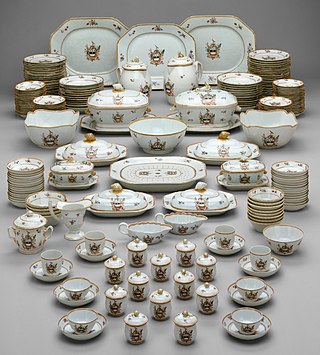
Chinese export porcelain includes a wide range of Chinese porcelain that was made (almost) exclusively for export to Europe and later to North America between the 16th and the 20th century. Whether wares made for non-Western markets are covered by the term depends on context. Chinese ceramics made mainly for export go back to the Tang dynasty if not earlier, though initially they may not be regarded as porcelain.

The Royal Crown Derby Porcelain Company is the oldest or second oldest remaining English porcelain manufacturer, based in Derby, England. The company, particularly known for its high-quality bone china, having produced tableware and ornamental items since approximately 1750. It was known as 'Derby Porcelain' until 1773, when it became 'Crown Derby', the 'Royal' being added in 1890.

Meissen porcelain or Meissen china was the first European hard-paste porcelain. Early experiments were done in 1708 by Ehrenfried Walther von Tschirnhaus. After his death that October, Johann Friedrich Böttger continued von Tschirnhaus's work and brought this type of porcelain to the market, financed by Augustus the Strong, King of Poland and Elector of Saxony. The production of porcelain in the royal factory at Meissen, near Dresden, started in 1710 and attracted artists and artisans to establish, arguably, the most famous porcelain manufacturer known throughout the world. Its signature logo, the crossed swords, was introduced in 1720 to protect its production; the mark of the swords is reportedly one of the oldest trademarks in existence.

Julio González i Pellicer, born in Barcelona, was a Spanish sculptor and painter who developed the expressive use of iron as a medium for modern sculpture. He was from a lineage of metalsmith workers and artists. His grandfather was a goldsmith worker and his father, Concordio González, a metalsmith worker who taught him the techniques of metalsmith in his childhood years. His mother, Pilar Pellicer Fenés, came from a long line of artists.

Hummel figurines are a series of porcelain figurines based on the drawings of Maria Innocentia Hummel.
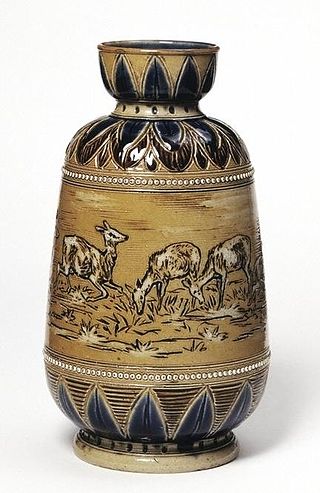
Royal Doulton is an English ceramic and home accessories manufacturer that was founded in 1815. Operating originally in Vauxhall, London, and later moving to Lambeth, in 1882 it opened a factory in Burslem, Stoke-on-Trent, in the centre of English pottery. From the start, the backbone of the business was a wide range of utilitarian wares, mostly stonewares, including storage jars, tankards and the like, and later extending to drain pipes, lavatories, water filters, electrical porcelain and other technical ceramics. From 1853 to 1901, its wares were marked Doulton & Co., then from 1901, when a royal warrant was given, Royal Doulton.
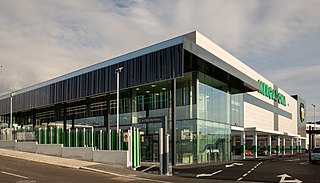
Mercadona is a Spanish supermarket chain, with 1,618 stores across Spain and 54 in Portugal.

The Lladró Museum is the family home of the Lladró brothers in Almàssera, a town close to Valencia in Spain. It has two permanent exhibits, the Historic Porcelain Museum and the Painting Collection. The family home is a typical Valencian house with exhibits of earlier artistic works, a patio with a Moorish kiln where its first porcelains were fired, and installations where children can learn activities.

The Khanenko Museum is an art museum located in Kyiv, in Ukraine, which holds the biggest and most valuable collections of European, Asian and Ancient art in the country.

John Rogers was an American sculptor who produced very popular, relatively inexpensive figurines in the latter 19th century.

The Frankenthal Porcelain Factory was one of the greatest porcelain manufacturers of Germany and operated in Frankenthal in the Rhineland-Palatinate between 1755 and 1799. From the start they made hard-paste porcelain, and produced both figurines and dishware of very high quality, somewhat reflecting in style the French origin of the business, especially in their floral painting. Initially they were a private business, but from 1761 were owned by the local ruler, like most German porcelain factories of the period.

The Imperial Porcelain Factory, also known as the Imperial Porcelain Manufactory, is a producer of hand-painted ceramics in Saint Petersburg, Russia. It was established by Dmitry Ivanovich Vinogradov in 1744 and was supported by the Russian tsars since Empress Elizabeth. Many still refer to the factory by its well-known former name, the Lomonosov Porcelain Factory.

Doccia porcelain, now usually called Richard-Ginori, at Doccia, a frazione of Sesto Fiorentino, near Florence, was in theory founded in 1735 by marchese Carlo Ginori near his villa, though it does not appear to have produced wares for sale until 1746. It has remained among the most important Italian porcelain factories ever since.

Tomás de Yepes or Hiepes was a Spanish painter in the Kingdom of Valencia. An artist of the Baroque movement, he worked as a painter of still life and bodegón—still life paintings depicting pantry items. He made paintings both for clients and public events. Although his activity started in the second decade of the 17th century, most of the works attributed to him come after 1642. He continued to paint until the year of his death.

The Royal Porcelain Factory in Berlin, also known as the Royal Porcelain Manufactory Berlin and whose products are generally called Berlin porcelain, was founded in 1763 by King Frederick II of Prussia. Its actual origins, however, lie in three private enterprises which, under crown patronage, were trying to establish the production of "white gold" in Berlin from the mid-18th century onwards.

California pottery includes industrial, commercial, and decorative pottery produced in the Northern California and Southern California regions of the U.S. state of California. Production includes brick, sewer pipe, architectural terra cotta, tile, garden ware, tableware, kitchenware, art ware, figurines, giftware, and ceramics for industrial use. Ceramics include terra cotta, earthenware, porcelain, and stoneware products.
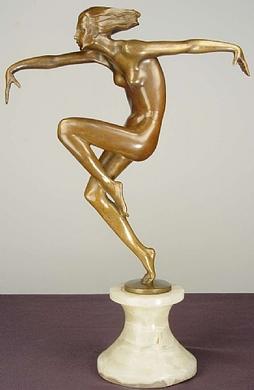
Josef Lorenzl was an Austrian sculptor and ceramicist of the Art Deco period, the same era as Ferdinand Preiss (1882–1943) and Demetre Chiparus (1886–1947).

Ceramic art is art made from ceramic materials, including clay. It may take varied forms, including artistic pottery, including tableware, tiles, figurines and other sculpture. As one of the plastic arts, ceramic art is a visual art. While some ceramics are considered fine art, such as pottery or sculpture, most are considered to be decorative, industrial or applied art objects. Ceramic art can be created by one person or by a group, in a pottery or a ceramic factory with a group designing and manufacturing the artware.

The Macau Scientific and Cultural Centre Museum in Lisbon is Portugal's main museum of Chinese artefacts and artworks. Made to document Sino-Portuguese relations, the museum contains over 3,500 works of art including decorative artwork, costumes, a collection of opium-smoking paraphernalia and an important extensive collection of Chinese ceramics.























